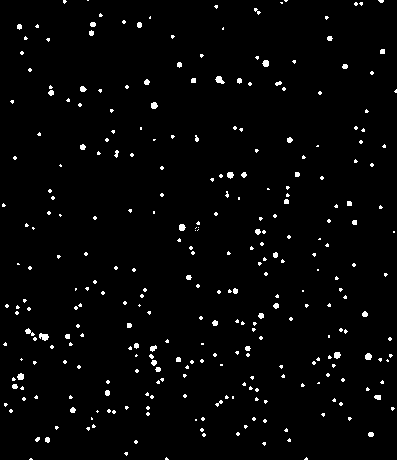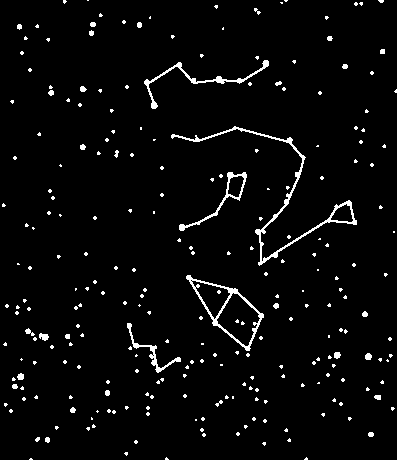

In this figure, stars that are brighter in the sky are shown as bigger white circles. (In fact, as seen from Earth all stars except the Sun just look like points of light, some of the points looks brighter than the rest because the star is unusually close or unusually bright.) Hipparchos (in the second century B.C.) called the brightest stars in the sky first magnitude stars, fairly bright stars (like those in the Big Dipper) second magnitude stars, etc. He called the dimmest stars he could see sixth magnitude stars That is, the brighter the star the smaller its magnitude. With telescopes we can now "see" stars much dimmer than sixth magnitude; very dim stars with magnitudes near 25 can now be measured.
Since the stars in the sky are fairly randomly arrayed, it seems to be a rather difficult task to learn where certain stars are. The star Vega, for example, will be in the northwest on December nights, nearly overhead on August nights, and in the northeast on April nights. The process of learning the stars is made possible by the discovery that, while stars move around in the sky, they keep the same relationship to each other year after year. Thus the star Vega can be identified because it is the bright star that has a dim parallelogram of stars within 10° of it. The parallelogram of stars follows Vega around where ever it goes. We can then invent patterns of neighboring stars by imagining certain (bright) stars to be "joined". The joined figures (stick figures of constellations) can then be learned separately from how one figure is positioned relative to another.

Here we have (from top to bottom), the stick figures for the Big Dipper, Draco, the Little Dipper, Cepheus, and Cassiopeia. Can you find the Big Dipper in the first picture? Did you notice it before you saw the stick figure?
Since different people see different stick figures in the sky, astronomers have developed a standard set of sky regions: the 88 official constellations cover the entire celestial sphere. The stick figures typically have the same sort of relationship to the official constellation as a highway map has with a country's border. Just as a small town, while certainly part of some country, may not be on any highway map, so a dim star may not be a vertex of any stick figure, but it is certainly part of some constellation.